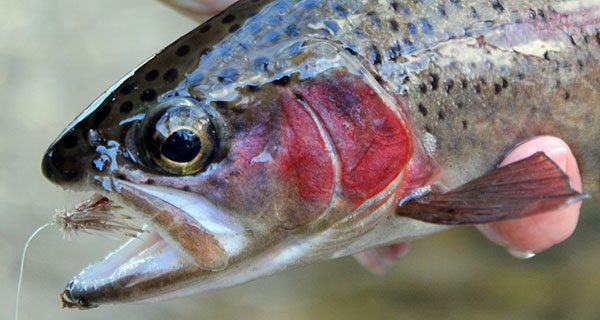Fall is my favorite time to fly fish. The colors are stunning and not just limited to the trees. The trout all seem brighter and are full of energy as they feed heavily in the months leading up to the lean winter season. Mayflies, like the blue-winged olive, emerge in good numbers, but the various caddis species probably get the fish more excited.
Here in the Smokies, the October caddis is a favorite bug for fly anglers to imitate for those in the know. The local rule of thumb is yellow dry flies from late spring through summer with a transition to orange in the fall. The big orange tinted caddis range from a size #10-#14. Not really the true October caddis that is found out west, these bugs still get the attention of the trout. This is especially true because many of the alternatives (such as blue-winged olives) are running a size #20-#24 this time of year. As far as bugs go, the October caddis is a big bite for mountain trout. The good news about this big bite is that it works deep into November most years.
I remember the first time I found good success with an October caddis imitation. I was fishing on Little River with typical low flows that are common in the fall. Fishing through a section of fast pocket water, I tied on the big dry fly, hoping to attract a quality trout. One slightly flatter section called for a longer cast.
My dry fly landed just downstream of a large boulder and drifted three or four feet before disappearing as a healthy rainbow slurped it gullibly down. When I set the hook, it was obvious this was not your average Smoky Mountain trout. The strong fish tore first downstream before reversing course and dashing back upstream again. Through each run, I was waiting for the fly to pull out or the tippet to break. Somehow, someway, everything held, and I soon landed a personal best 15-inch wild rainbow.
I still look back on that moment many years ago and keep hoping for another big trout. Since then, countless rainbow, brown, and brook trout have fallen for an October caddis dry, but I’m still looking for one as large as that memorable first rainbow trout.
My favorite way of fishing this dry fly is in the pocket water that is prevalent on most Smoky Mountain streams. I usually hang a bead head caddis pupa in size #14-#18 approximately 18 inches under the dry fly. Remember that in the Great Smoky Mountains, you are allowed the use of one dropper but must have at least 12 inches between your two flies. On most days, fish will fall for each fly 50/50. On the best of days, the fish will key in on the dry fly and you can remove the dropper. In fact, my best numbers days in the Smokies have all come on dry flies. Those are the days you live for as an angler, and the October caddis is an excellent choice to tie on if you want to catch a lot of trout in the mountains this fall.
David Knapp is an author and fly fishing guide, specializing in trips in the Great Smoky Mountains National Park and on Tennessee tailwaters like the Clinch and Caney Fork Rivers. David is a former high school mathematics teacher who decided to change classrooms beginning in 2014 and has been spending his time teaching others to fly fish ever since. Look him up to reserve your guided trip at TroutZoneAnglers@gmail.com or call/text him at (931) 261-1884. Website: www.troutzoneanglers.com
